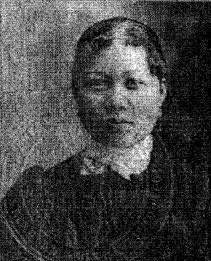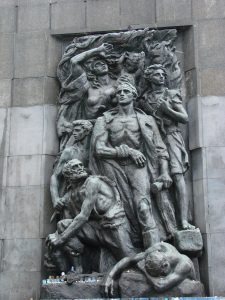In 1899, Ah Sou, a Chinese orphan, was sold to a man named Moy Sam with the belief that she would accompany him to the United States of America to become his daughter. There are no records indicating why or how she was sold. After her trip across the Pacific Ocean, she landed at Port Townsend, Washington, on August 23, 1900, and discovered that she would be forced into prostitution.1 Despite learning this, she followed the orders she was given, and told immigration inspectors at the entry port that Moy Sam was her father and a merchant.

After enduring three years of abuse from Moy Sam, she overheard that she was about to be sold to another man for further exploitation. She decided that she needed to act fast before being sold, and found a way to escape in November of 1903 to The Home for Chinese Women and Girls. Reverend William Holt and his wife, Frances Holt, unintentionally founded the home in Portland, Oregon after serving as American missionaries in China. It began with one Chinese woman who sought refuge with Reverend and Mrs. Holt; not long after, more women followed her lead. Eventually, the home, located at 350 Fourteenth Street, was opened in April 1889.2
There was a Board of Directors of the Home in Portland, which gave it a certain degree of legitimacy. The home taught the women how to speak English, as well as how to read English and Chinese. They were educated in various skills, such as housework, needle-work, and Bible studies. Mrs. Holt said, “They eat Chinese food, wear Chinese clothes, except the shoes, have very plain furniture in their rooms, and are led to look forward to such lives as respectable, intelligent Chinese women may hope to enjoy. The purpose is not to make them over into American women, which might end in dissatisfaction and unhappiness by and by, but we want them to develop into good, useful Chinese women.”3 The home was such a success that a deaf-mute girl, who was raised there, gave a speech at a board meeting, gesturing, “More love to thee.”4

While Ah Sou was at the home, she was the only girl there, which made the days long and boring for her. While she was there, she was married by Reverend Holt to a Chinese man named Lum Kong, because they believed that he was a Chinese merchant. That was important, because being married to a Chinese merchant meant that Ah Sou would be able to legally stay in America. After a number of weeks, Ah Sou made it very clear that she wanted to leave the home, because being the only girl there made her feel very lonely. Frances Holt and the staff did not like the idea of her leaving. Mrs. Holt said, “We wished [Ah Sou] to stay, we did everything we could to persuade her to stay, we hoped she would stay with us for a year or more and it was [Lum Kong’s] wish that she stay, but she said she did not want to, she preferred to leave.”5 Although Lum Kong wanted Ah Sou to stay, he did nothing to keep her from leaving because their marriage did not mean much to him. He knew that the sole reason for their marriage was to try to legalize her status in the United States.
After she left the home, Ah Sou traveled to Seattle where she ran into Moy Sam, who was cooperating with law enforcement to have her arrested. On January 1, 1904, she was arrested by an immigration inspector, and on January 8, 1904, Commissioner James Kiefer ordered her to be deported to China. In between her apprehension and the deportation order, there was a lengthy hearing at which a number of witnesses testified. These witnesses included: the immigration inspectors who arrested and interviewed Ah Sou, a baggageman for the Northern Pacific Railroad who knew Moy Sam, the photographer who helped Moy Sam create a fake family photograph, Mrs. Holt, the employer of Lum Kong, and Lum Kong. When Ah Sou was asked about her time with Moy Sam she said, “I was whipped and beaten by [Moy Sam]. Every day I was beaten by him with sticks of wood until I was black and blue.”6 She also informed the court that she never received any of her earnings during her time with Moy Sam. At the end of the hearing, it was decided that the only reason for Ah Sou’s marriage was so that she would not be deported, thus making her deportable. She was seen as nothing more than an illegal immigrant turned prostitute. However, Ah Sou refused to give up and appealed the deportation order to the United States District Court for the District of Washington, where Judge Cornelius Hanford presided over her appeal.

Although Judge Hanford’s further investigation led him to find out that Lum Kong was not actually a merchant, and he agreed that Ah Sou’s marriage was not bona fide, he still decided to reverse the deportation order. Judge Hanford stated, “The laws excluding Chinese immigrants and women imported for immoral purposes require the court to cause a person in the situation of the appellant to be deported to China. Compliance with the statute in this case will be, in my estimation, a barbarous proceeding, for it will be equivalent to remanding the appellant to perpetual slavery and degradation.”7 He also emphasized Ah Sou’s great effort to escape Moy Sam and create a life for herself. He stressed that the Thirteenth Amendment prohibits slavery and that the only way she could be emancipated was if she was released from custody and allowed to remain in America. Unfortunately, the government appealed Judge Hanford’s decision to the United States Court of Appeals for the Ninth Circuit.
Ah Sou argued that the court did not have any right to her case, and said, “[The] sole question involved is the application of the thirteenth amendment to the Constitution of the United States, and that therefore the appellate jurisdiction of the Supreme Court is exclusive.” However, the Judiciary Act of 1891 gave the Supreme Court exclusive jurisdiction over “the construction or application of the Constitution of the United States.”8 This court ruled, “We see no escape from the conclusion that the judgment of the trial court must be reversed, and the appellee remanded to the country whence she came.”9 Ah Sou tried appealing this ruling to the Supreme Court, but her appeal was denied for lack of jurisdiction. On March 8, 1906 Ah Sou was placed aboard a steamer named “Manchuria,” and left San Francisco for Hong Kong, China. That is where her records end; nothing more was heard of Ah Sou.10
Unfortunately, there are many other stories just like Ah Sou’s, where young girls are sexually exploited and are seen as nothing more than illegal immigrants. More recently, the Trafficking Victims Protection Act of 2000 has been created to help persons trafficked and ensure that traffickers face adequate consequences. This act ensures that governments have recovery centers that provide medical treatments to heal the physical and mental abuse that victims endure. Yet there are still instances like Ah Sou’s that have holes and gaps in their journey that may never be discovered, as sex-trafficking victims are only provided minimal care so that some governments can say that they are doing their job to make sure the victims are accounted for.11
It is not shocking that a Chinese orphan was so easily tricked into being trafficked. Sex trafficking is still a global issue, but is especially prevalent in China. During China’s early years of economic liberalization, sex establishments were operated in the Special Economic Zones. These establishments catered to everyone–clients ranged from local businessmen to foreign investors. The sex-trafficking industry is so common in China, that every major city has a red-light district, which is where sex establishments congregate to make it easier for people to locate them.12 If you or anyone you know is being sex-trafficked or at risk, the National Human Trafficking Hotline is +1 (888) 373-7888. They have translators that speak over 200 language who are available 24/7. If you would like to send them a message, text “HELP” or “INFO” to 233733. For more information please visit https://humantraffickinghotline.org/.13
- Margaret McKeown and Emily Ryo, “The Lost Sanctuary: Examining Sex Trafficking Through the Lens of United States v. Ah Sou,” Cornell International Law Journal 41, no. 3 (2008): 748. ↵
- Margaret McKeown and Emily Ryo, “The Lost Sanctuary: Examining Sex Trafficking Through the Lens of United States v. Ah Sou,” Cornell International Law Journal 41, no. 3 (2008): 749. ↵
- Margaret McKeown and Emily Ryo, “The Lost Sanctuary: Examining Sex Trafficking Through the Lens of United States v. Ah Sou,” Cornell International Law Journal 41, no. 3 (2008): 750. ↵
- David Livingstone, “What Japanese Christian Women are Doing for Korea,” Woman’s Work 48, no. 3 (1913): 165. ↵
- Margaret McKeown and Emily Ryo, “The Lost Sanctuary: Examining Sex Trafficking Through the Lens of United States v. Ah Sou,” Cornell International Law Journal 41, no. 3 (2008): 751. ↵
- Margaret McKeown and Emily Ryo, “The Lost Sanctuary: Examining Sex Trafficking Through the Lens of United States v. Ah Sou,” Cornell International Law Journal 41, no. 3 (2008): 749. ↵
- Margaret McKeown and Emily Ryo, “The Lost Sanctuary: Examining Sex Trafficking Through the Lens of United States v. Ah Sou,” Cornell International Law Journal 41, no. 3 (2008): 753. ↵
- Margaret McKeown and Emily Ryo, “The Lost Sanctuary: Examining Sex Trafficking Through the Lens of United States v. Ah Sou,” Cornell International Law Journal 41, no. 3 (2008): 754-755. ↵
- Margaret McKeown and Emily Ryo, “The Lost Sanctuary: Examining Sex Trafficking Through the Lens of United States v. Ah Sou,” Cornell International Law Journal 41, no. 3 (2008): 755. ↵
- Margaret McKeown and Emily Ryo, “The Lost Sanctuary: Examining Sex Trafficking Through the Lens of United States v. Ah Sou,” Cornell International Law Journal 41, no. 3 (2008): 755. ↵
- “2018 Trafficking in Persons Report” (Department of State, June 2018), 4,39 https://www.state.gov/documents/organization/282798.pdf. ↵
- Bonny Ling, “Human Trafficking and China: Past and Present” (Thesis, National University of Ireland Galway, 2014), http://hdl.handle.net/10379/4730. ↵
- “National Human Trafficking Hotline,” National Human Trafficking Hotline, accessed April 6, 2019, https://humantraffickinghotline.org/node. ↵



55 comments
Sharriah Martinez
This articles title was captivating ! thank you so much for such a great read and congrats on your nomination for an award it was well deserved. I had never known about Ah Shou , her life was interesting . It was very sad. It was sad that she was sent back to china. I saw here in this article people not being kind and treating others the way they would like to be treated.
Natalie Thamm
This article is amazing, but heartbreaking. Ah Sho’s story is devastating and unfortunately women, children and men suffer from sex trafficking every day, even here in the United States today. It is absolutely absurd that someone would be punished for being the victim in a situation but showcases how easily it can happen. I really liked that the author ended the article by highlighting that this is a continuing issue and by providing the information to contact help.
Diego Terrazas
It is truly unbearable to read how such innocent people are abused and only meet misfortune. This may be a while back but the issue of sex trafficking still pertains. I hope that the US takes the initiative to put an end to this worldwide issue instead of focusing on issues like immigration, at least as far as immigration in the United States goes.
Ruben Basaldu
This article is so well written and so informative. This is just a really great article and I am glad I read it. Sex trafficking has been a thing for many years sadly and it is still going on to this day which is so wrong. This while was a great article was very saddening to read about because of what happened to Ah Shou. She wanted things to be different instead she was put into a life that would involve sexual and physical abuse. Great article but such a sad topic.
Ryan Estes
As I said with the Larry Nassar article, no woman should go through this. It’s complete crap how some guys treat girls sometimes. I’m sorry for cussing a little, but I just get angry when I read a title like that and think about the suffering this person had to go through. I’m no stranger to suffering myself, but I don’t complain about it. I try not to. Some things from my past are hard to let go of, but once I settled down and started training my mind it’s slowly becoming muscle memory.
Diamond Davidson
It is so upsetting to read about the life of Ah Shou. I wish that people would have been less mean and more nice to her, and should of been allowed to remain in the U.S. It’s crazy to understand that she was sent back not knowing what would probably happen to her when she returned to China. This was a lot og good information that really flowed well and it was a well-written article, good job.
Mariah Cavanaugh
Congratulations on your nomination! Your article was truly inspirational, and I was caught off guard by Judge Hanford’s ruling on Ah Sou’s deportation. I did not expect such an open-minded ruling in favor of an immigrant woman. I absolutely love the fact that you used Ah Sou’s story to highlight the many women who become victims of sexual exploitation and trafficking. Great job!
Sydney Aleman
I have always known that sex trafficking has been a global trouble and it has always been around. It is sad to hear how even then no one did much to protect those who were forced into sex trafficking and if there was help it was very minimal. Knowing that Ah Sou was deported back to China is sad, but not as sad how sex trafficking still exist in present day. I believe this is a topic more people of power need to focus on because it involves women of all ages and it is right in the first place.
Hamza Bourouz
Great job. I found the article very informative and eye opening. it is definitely heart breaking to learn about the horrific injustices Ah Shou indured in her life since coming to the states. unfortunetely being forced into prosititution and then arrested and threatened by deportation is the story of many women around the world even in the age of Human rights.
Engelbert Madrid
It is unfortunate to read how Ah Shou’s life fell apart after being sold and used for sex trafficking. After her first escape from Moy Sam, I believe she felt tremendously in peace and eager to be free from her predator. However, I can’t believe that the United States let Moy Sam take Ah Shou after hearing her say that he abused her in several ways.